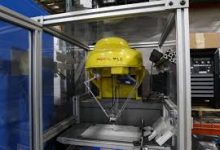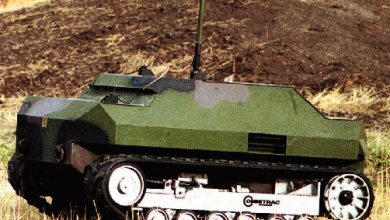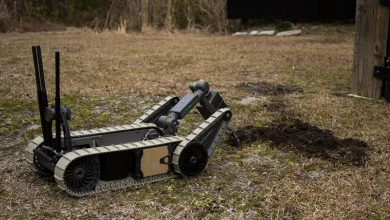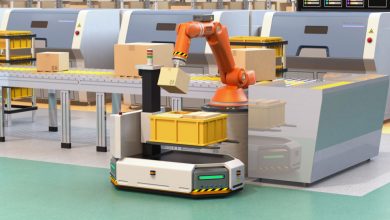Types of Industrial Robotics: Applications, and Advancements

Industrial robotics represents a dynamic and diverse field encompassing a wide range of robots tailored to specific applications and industries. From articulated arms and SCARA robots to gantry systems and collaborative robots, the industrial robotics landscape is characterized by innovation, versatility, and adaptability. This comprehensive exploration delves into the various types of industrial robotics, their unique features, applications, and contributions to modern manufacturing.
Articulated Robots:
Articulated robots, characterized by multiple rotary joints resembling a human arm, are among the most common types of industrial robots used in manufacturing. These robots offer a high degree of freedom and flexibility, allowing them to perform complex tasks such as welding, painting, and assembly with precision and efficiency. Articulated robots are widely deployed in industries such as automotive, electronics, and aerospace for tasks such as spot welding, material handling, and machine tending.
Versatility of Articulated Robots in Modern Manufacturing
Articulated robots stand as pillars of versatility and precision in the realm of industrial automation. With their multi-jointed arms mimicking the flexibility of a human arm, these robots are capable of executing a wide range of tasks with agility and accuracy. From assembly and welding to painting and material handling, articulated robots have become indispensable tools in modern manufacturing. This comprehensive exploration delves into the intricacies of articulated robots, their unique features, applications, and transformative impact on industrial processes.
-
Anatomy of Articulated Robots:
At the heart of articulated robots lies their unique structure, comprising multiple interconnected segments or links joined by rotary joints, known as axes. These axes provide the robot with a high degree of freedom, allowing it to move its end-effector in various directions and orientations. Articulated robots typically consist of a base or pedestal, followed by a series of joints arranged in a chain-like fashion, terminating in an end-effector where tools or grippers are attached. The number of axes can vary, with common configurations including 6-axis, 7-axis, and even higher degrees of freedom for specialized applications.
-
Motion and Kinematics:
Articulated robots leverage the principles of kinematics to achieve precise motion control and manipulation of objects in three-dimensional space. By controlling the rotation of each joint, articulated robots can perform a wide range of motions, including rotation, translation, and combinations thereof. Kinematic equations govern the relationship between joint angles and the position/orientation of the end-effector, allowing for accurate trajectory planning and path following. Advanced motion planning algorithms, such as inverse kinematics, enable articulated robots to compute joint angles required to achieve a desired end-effector pose, facilitating tasks such as pick-and-place operations, assembly, and machining.
-
Applications in Manufacturing:
Articulated robots find diverse applications across various industries and sectors, owing to their versatility, precision, and efficiency. In automotive manufacturing, articulated robots are used for tasks such as welding, painting, assembly, and material handling. Welding robots perform arc welding, spot welding, and laser welding operations with high speed and accuracy, ensuring consistent weld quality and productivity. Painting robots apply coatings and finishes to vehicle bodies with precision and uniformity, enhancing aesthetic appeal and corrosion resistance. Assembly robots automate the assembly of components such as engines, transmissions, and interiors, reducing cycle times and labor costs. Material handling robots transport parts and components between production stations, optimizing workflow and throughput in assembly lines.
-
Advancements in Technology:
Articulated robots have benefited from advancements in technology, including improvements in materials, actuators, sensors, and control systems. Lightweight materials such as aluminum and carbon fiber have enabled the development of more agile and energy-efficient robots with higher payload capacities. High-performance electric motors, servo drives, and harmonic gearboxes provide precise and reliable motion control, enhancing robot performance and productivity. Advanced sensors, such as encoders, accelerometers, and force/torque sensors, enable robots to perceive and respond to changes in their environment, ensuring safe and accurate operation. Moreover, advancements in control algorithms and software enable articulated robots to perform complex tasks with speed, accuracy, and adaptability, driving efficiency and innovation in manufacturing processes.
-
Collaborative and Flexible Automation:
In recent years, there has been a growing trend towards collaborative and flexible automation in manufacturing, with articulated robots playing a key role in enabling human-robot collaboration and adaptability. Collaborative articulated robots, or cobots, are designed to work alongside humans in shared workspaces, performing tasks that require close interaction and cooperation. Cobots are equipped with advanced safety features such as force limiting, speed monitoring, and collision detection, ensuring safe operation in proximity to human workers. Moreover, articulated robots offer flexibility and reconfigurability, allowing manufacturers to adapt to changing production requirements and customize robot configurations for different tasks and environments.
-
Conclusion:
In conclusion, articulated robots represent a cornerstone of modern manufacturing, offering versatility, precision, and efficiency in a wide range of industrial applications. From automotive assembly lines to electronics manufacturing facilities, articulated robots have become indispensable tools for automating tasks such as welding, painting, assembly, and material handling. With advancements in technology and the emergence of collaborative and flexible automation, articulated robots are poised to continue driving innovation and transformation in manufacturing processes, unlocking new levels of productivity, quality, and competitiveness in the global marketplace.
-
SCARA Robots:
Selective Compliance Assembly Robot Arm (SCARA) robots are designed for applications requiring high speed and precision in a horizontal plane. These robots feature a rigid arm structure with two parallel joints that provide compliance in the vertical direction, allowing for precise positioning and assembly tasks. SCARA robots are commonly used in industries such as electronics, semiconductor manufacturing, and consumer goods for tasks such as pick-and-place assembly, packaging, and soldering.
Precision and Agility of SCARA Robots in Manufacturing
SCARA robots stand as stalwarts of precision and agility in industrial automation, offering a unique combination of speed, accuracy, and versatility. Their Selective Compliance Assembly Robot Arm (SCARA) configuration, characterized by a rigid arm structure with two parallel joints, enables precise horizontal motion ideal for assembly and pick-and-place operations. From electronics manufacturing to pharmaceutical packaging, SCARA robots have found widespread application across various industries. This comprehensive exploration delves into the intricacies of SCARA robots, their distinctive features, applications, and transformative impact on manufacturing processes.
-
Anatomy of SCARA Robots:
At the core of SCARA robots lies their distinctive mechanical structure, comprising a rigid arm with two parallel joints arranged in a horizontal plane. This configuration allows SCARA robots to achieve precise horizontal motion while maintaining rigidity and stability. SCARA robots typically consist of a base or pedestal, followed by two revolute joints that provide compliance in the vertical direction, and a tool or end-effector mounted at the end of the arm. The parallel configuration of the joints enables SCARA robots to move in a plane parallel to the work surface, making them well-suited for applications requiring precise horizontal motion.
-
Motion and Kinematics:
SCARA robots leverage the principles of kinematics to achieve precise motion control and manipulation of objects in a horizontal plane. By controlling the rotation of the two parallel joints, SCARA robots can perform a wide range of motions, including translation, rotation, and combinations thereof. Kinematic equations govern the relationship between joint angles and the position/orientation of the end-effector, allowing for accurate trajectory planning and path following. Advanced motion planning algorithms, such as inverse kinematics, enable SCARA robots to compute joint angles required to achieve a desired end-effector pose, facilitating tasks such as pick-and-place operations, assembly, and packaging.
-
Applications in Manufacturing:
SCARA robots find diverse applications across various manufacturing industries, owing to their precision, speed, and versatility. In electronics manufacturing, SCARA robots are used for tasks such as pick-and-place assembly, soldering, and testing of electronic components. These robots offer fast cycle times and high repeatability, ensuring consistent quality and productivity in production processes. In pharmaceutical manufacturing, SCARA robots are employed for tasks such as dispensing, packaging, and labeling of pharmaceutical products. Their precise motion control and compact footprint make them well-suited for applications requiring high throughput and space efficiency. Additionally, SCARA robots find applications in industries such as automotive, consumer goods, and food and beverage for tasks such as assembly, inspection, and packaging.
-
Advancements in Technology:
SCARA robots have benefited from advancements in technology, including improvements in materials, actuators, sensors, and control systems. Lightweight materials such as aluminum and carbon fiber have enabled the development of more agile and energy-efficient robots with higher payload capacities. High-performance electric motors, servo drives, and harmonic gearboxes provide precise and reliable motion control, enhancing robot performance and productivity. Advanced sensors, such as encoders, proximity sensors, and vision systems, enable SCARA robots to perceive their environment and respond to changes in real-time, ensuring safe and accurate operation. Moreover, advancements in control algorithms and software enable SCARA robots to perform complex tasks with speed, accuracy, and adaptability, driving efficiency and innovation in manufacturing processes.
-
Collaborative and Flexible Automation:
In recent years, there has been a growing trend towards collaborative and flexible automation in manufacturing, with SCARA robots playing a key role in enabling human-robot collaboration and adaptability. Collaborative SCARA robots are designed to work alongside humans in shared workspaces, performing tasks that require close interaction and cooperation. These robots are equipped with advanced safety features such as force limiting, speed monitoring, and collision detection, ensuring safe operation in proximity to human workers. Moreover, SCARA robots offer flexibility and reconfigurability, allowing manufacturers to adapt to changing production requirements and customize robot configurations for different tasks and environments.
Conclusion:
In conclusion, SCARA robots represent a pinnacle of precision and agility in modern manufacturing, offering versatility, speed, and accuracy in a wide range of industrial applications. From electronics assembly to pharmaceutical packaging, SCARA robots have become indispensable tools for automating tasks requiring precise horizontal motion. With advancements in technology and the emergence of collaborative and flexible automation, SCARA robots are poised to continue driving innovation and transformation in manufacturing processes, unlocking new levels of productivity, quality, and competitiveness in the global marketplace.
-
Cartesian Robots:
Cartesian robots, also known as gantry robots or linear robots, utilize linear motion along orthogonal axes (X, Y, Z) to perform tasks such as material handling, assembly, and machining. These robots feature a rigid structure with linear actuators or belts that move along fixed rails or tracks, enabling precise and repeatable motion. Cartesian robots are suitable for applications requiring large work envelopes, high payload capacity, and precise positioning accuracy, such as CNC machining, 3D printing, and packaging.
Precision and Flexibility of Cartesian Robots in Industrial Automation
Cartesian robots, also known as gantry robots or linear robots, stand as stalwarts of precision and flexibility in industrial automation. Their distinctive configuration, characterized by linear motion along orthogonal axes (X, Y, Z), enables precise positioning and manipulation of objects in three-dimensional space. From CNC machining and 3D printing to packaging and material handling, Cartesian robots have found widespread application across various industries. This comprehensive exploration delves into the intricacies of Cartesian robots, their unique features, applications, and transformative impact on manufacturing processes.
-
Anatomy of Cartesian Robots:
At the core of Cartesian robots lies their distinctive mechanical structure, comprising linear actuators or belts that drive motion along orthogonal axes (X, Y, Z). This configuration allows Cartesian robots to achieve precise motion in three-dimensional space while maintaining rigidity and stability. Cartesian robots typically consist of a base or frame, followed by linear actuators or belts that move along fixed rails or tracks in the X, Y, and Z directions, and a tool or end-effector mounted at the end of the arm. The linear motion along orthogonal axes enables Cartesian robots to move in a straight line or along predefined paths, making them well-suited for applications requiring precise and repeatable motion.
-
Motion and Kinematics:
Cartesian robots leverage the principles of kinematics to achieve precise motion control and manipulation of objects in three-dimensional space. By controlling the movement of linear actuators or belts along orthogonal axes, Cartesian robots can perform a wide range of motions, including translation, rotation, and combinations thereof. Kinematic equations govern the relationship between linear displacements along each axis and the position/orientation of the end-effector, allowing for accurate trajectory planning and path following. Advanced motion planning algorithms enable Cartesian robots to compute the trajectory required to achieve a desired end-effector pose, facilitating tasks such as CNC machining, 3D printing, and packaging.
-
Applications in Manufacturing:
Cartesian robots find diverse applications across various manufacturing industries, owing to their precision, flexibility, and scalability. In CNC machining, Cartesian robots are used for tasks such as milling, drilling, and routing of materials such as metal, wood, and composites. These robots offer high precision and repeatability, ensuring accurate machining of complex geometries and tight tolerances. In 3D printing, Cartesian robots are employed for additive manufacturing of parts and components using various materials such as plastics, metals, and ceramics. Their precise motion control and large build volume make them well-suited for producing prototypes, tooling, and end-use parts. Additionally, Cartesian robots find applications in packaging, material handling, and logistics for tasks such as palletizing, sorting, and conveyor handling. Their scalability and modularity enable manufacturers to customize robot configurations for different tasks and production requirements.
-
Advancements in Technology:
Cartesian robots have benefited from advancements in technology, including improvements in materials, actuators, sensors, and control systems. Lightweight materials such as aluminum and carbon fiber have enabled the development of more agile and energy-efficient robots with higher payload capacities. High-performance linear actuators, servo drives, and linear guides provide precise and reliable motion control, enhancing robot performance and productivity. Advanced sensors, such as encoders, proximity sensors, and vision systems, enable Cartesian robots to perceive their environment and respond to changes in real-time, ensuring safe and accurate operation. Moreover, advancements in control algorithms and software enable Cartesian robots to perform complex tasks with speed, accuracy, and adaptability, driving efficiency and innovation in manufacturing processes.
-
Collaborative and Flexible Automation:
In recent years, there has been a growing trend towards collaborative and flexible automation in manufacturing, with Cartesian robots playing a key role in enabling human-robot collaboration and adaptability. Collaborative Cartesian robots are designed to work alongside humans in shared workspaces, performing tasks that require close interaction and cooperation. These robots are equipped with advanced safety features such as force limiting, speed monitoring, and collision detection, ensuring safe operation in proximity to human workers. Moreover, Cartesian robots offer flexibility and reconfigurability, allowing manufacturers to adapt to changing production requirements and customize robot configurations for different tasks and environments.
-
Conclusion:
In conclusion, Cartesian robots represent a pinnacle of precision and flexibility in modern manufacturing, offering versatility, scalability, and reliability in a wide range of industrial applications. From CNC machining and 3D printing to packaging and material handling, Cartesian robots have become indispensable tools for automating tasks requiring precise motion control in three-dimensional space. With advancements in technology and the emergence of collaborative and flexible automation, Cartesian robots are poised to continue driving innovation and transformation in manufacturing processes, unlocking new levels of productivity, quality, and competitiveness in the global marketplace.
-
Delta Robots:
Delta robots, characterized by a parallel kinematic structure with three or more arms connected to a common base, are designed for high-speed and high-precision pick-and-place applications. These robots feature a lightweight and compact design, making them ideal for tasks such as sorting, packaging, and assembly in industries such as food and beverage, pharmaceuticals, and electronics. Delta robots offer fast acceleration and deceleration capabilities, enabling them to achieve high throughput and cycle times in production processes.
Precision and Speed of Delta Robots in Industrial Automation
Delta robots, with their distinctive parallel kinematic structure and remarkable speed and precision, have emerged as key players in the realm of industrial automation. These robots, characterized by a parallel arrangement of three or more arms connected to a common base, excel in high-speed pick-and-place operations, packaging, and assembly tasks. From food and beverage production to electronics manufacturing, Delta robots have found widespread application across various industries. This comprehensive exploration delves into the intricacies of Delta robots, their unique features, applications, and transformative impact on manufacturing processes.
-
Anatomy of Delta Robots:
At the heart of Delta robots lies their unique mechanical structure, comprising three or more arms connected to a common base via universal joints or parallelogram linkages. This parallel kinematic structure enables Delta robots to achieve precise and coordinated motion with remarkable speed and agility. Delta robots typically consist of a base or pedestal, followed by three or more arms arranged in a triangular or pyramidal configuration, and a tool or end-effector mounted at the end of each arm. The parallel arrangement of the arms enables Delta robots to move in a coordinated manner, making them well-suited for applications requiring high-speed and high-precision motion.
-
Motion and Kinematics:
Delta robots leverage the principles of parallel kinematics to achieve precise and coordinated motion control. By controlling the length and orientation of each arm simultaneously, Delta robots can perform a wide range of motions, including translation, rotation, and combinations thereof. Kinematic equations govern the relationship between the lengths and orientations of the arms and the position/orientation of the end-effector, allowing for accurate trajectory planning and path following. Advanced motion planning algorithms enable Delta robots to compute the trajectory required to achieve a desired end-effector pose, facilitating tasks such as pick-and-place operations, packaging, and assembly.
-
Applications in Manufacturing:
Delta robots find diverse applications across various manufacturing industries, owing to their speed, precision, and versatility. In food and beverage production, Delta robots are used for tasks such as packaging, sorting, and palletizing of products such as bottles, cans, and cartons. These robots offer fast cycle times and high throughput, ensuring efficient handling of products in high-volume production lines. In electronics manufacturing, Delta robots are employed for tasks such as pick-and-place assembly, soldering, and testing of electronic components. Their precise motion control and compact footprint make them well-suited for applications requiring high-speed and high-precision assembly. Additionally, Delta robots find applications in industries such as pharmaceuticals, cosmetics, and consumer goods for tasks such as packaging, labeling, and inspection.
-
Advancements in Technology:
Delta robots have benefited from advancements in technology, including improvements in materials, actuators, sensors, and control systems. Lightweight materials such as aluminum and carbon fiber have enabled the development of more agile and energy-efficient robots with higher payload capacities. High-performance electric motors, servo drives, and harmonic gearboxes provide precise and reliable motion control, enhancing robot performance and productivity. Advanced sensors, such as encoders, proximity sensors, and vision systems, enable Delta robots to perceive their environment and respond to changes in real-time, ensuring safe and accurate operation. Moreover, advancements in control algorithms and software enable Delta robots to perform complex tasks with speed, accuracy, and adaptability, driving efficiency and innovation in manufacturing processes.
-
Collaborative and Flexible Automation:
In recent years, there has been a growing trend towards collaborative and flexible automation in manufacturing, with Delta robots playing a key role in enabling human-robot collaboration and adaptability. Collaborative Delta robots are designed to work alongside humans in shared workspaces, performing tasks that require close interaction and cooperation. These robots are equipped with advanced safety features such as force limiting, speed monitoring, and collision detection, ensuring safe operation in proximity to human workers. Moreover, Delta robots offer flexibility and reconfigurability, allowing manufacturers to adapt to changing production requirements and customize robot configurations for different tasks and environments.
-
Conclusion:
In conclusion, Delta robots represent a pinnacle of speed and precision in modern manufacturing, offering versatility, efficiency, and reliability in a wide range of industrial applications. From food and beverage packaging to electronics assembly, Delta robots have become indispensable tools for automating tasks requiring high-speed and high-precision motion. With advancements in technology and the emergence of collaborative and flexible automation, Delta robots are poised to continue driving innovation and transformation in manufacturing processes, unlocking new levels of productivity, quality, and competitiveness in the global marketplace.
-
Collaborative Robots (Cobots):
Collaborative robots, or cobots, are designed to work alongside humans in shared workspaces, performing tasks that require close collaboration and interaction. These robots are equipped with advanced sensors and safety features that enable safe and intuitive interaction with human operators. Cobots find applications in tasks such as assembly, inspection, packaging, and material handling, enhancing productivity, flexibility, and ergonomics in manufacturing operations. They are widely used in industries such as automotive, aerospace, electronics, and healthcare for tasks such as assembly line tending, quality inspection, and logistics.
-
Mobile Robots:
Mobile robots are equipped with mobility capabilities to move autonomously or semi-autonomously in their environment. These robots include wheeled robots, tracked robots, legged robots, and aerial drones. Mobile robots are used for tasks such as material transport, inventory management, and surveillance in industries such as warehousing, logistics, and agriculture. They offer flexibility and adaptability in dynamic and unstructured environments, enabling efficient and cost-effective automation of various tasks.
-
Autonomous Vehicles:
Autonomous vehicles, also known as self-driving or driverless vehicles, use robotics technology to navigate and operate without human intervention. These vehicles include autonomous cars, trucks, drones, and unmanned aerial vehicles (UAVs). Autonomous vehicles rely on sensors, cameras, GPS, and AI algorithms to perceive their environment, plan routes, and make decisions. They find applications in industries such as transportation, logistics, agriculture, and mining for tasks such as goods delivery, mapping, and surveillance.
Conclusion:
In conclusion, the diverse types of industrial robotics represent a spectrum of capabilities and applications that drive efficiency, productivity, and innovation in modern manufacturing. From articulated arms and SCARA robots to collaborative robots and autonomous vehicles, industrial robotics offers a wide range of solutions tailored to specific tasks and industries. As technology continues to advance and evolve, the integration of robotics with emerging technologies such as artificial intelligence, machine learning, and IoT connectivity will further expand the possibilities of automation and robotics in manufacturing, unlocking new levels of efficiency, flexibility, and competitiveness in the global marketplace.




